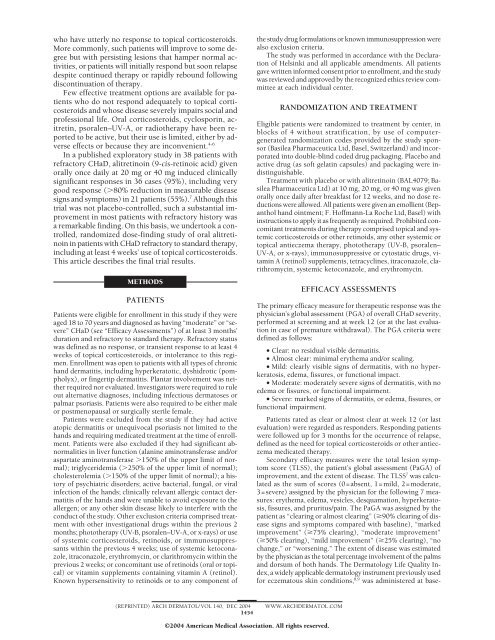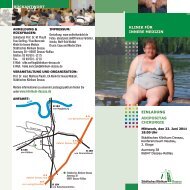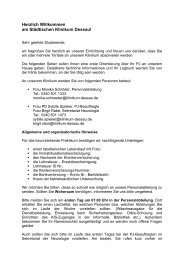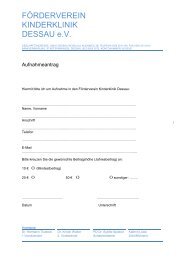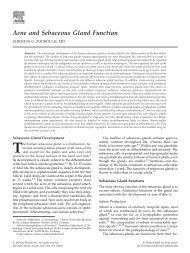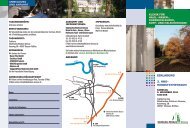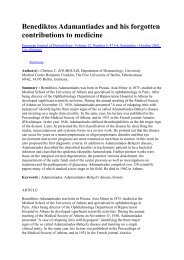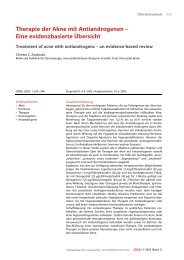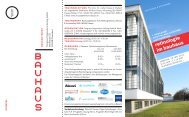View - Städtisches Klinikum Dessau
View - Städtisches Klinikum Dessau
View - Städtisches Klinikum Dessau
You also want an ePaper? Increase the reach of your titles
YUMPU automatically turns print PDFs into web optimized ePapers that Google loves.
who have utterly no response to topical corticosteroids.<br />
More commonly, such patients will improve to some degree<br />
but with persisting lesions that hamper normal activities,<br />
or patients will initially respond but soon relapse<br />
despite continued therapy or rapidly rebound following<br />
discontinuation of therapy.<br />
Few effective treatment options are available for patients<br />
who do not respond adequately to topical corticosteroids<br />
and whose disease severely impairs social and<br />
professional life. Oral corticosteroids, cyclosporin, acitretin,<br />
psoralen–UV-A, or radiotherapy have been reported<br />
to be active, but their use is limited, either by adverse<br />
effects or because they are inconvenient. 4-6<br />
In a published exploratory study in 38 patients with<br />
refractory CHaD, alitretinoin (9-cis-retinoic acid) given<br />
orally once daily at 20 mg or 40 mg induced clinically<br />
significant responses in 36 cases (95%), including very<br />
good response (�80% reduction in measurable disease<br />
signs and symptoms) in 21 patients (55%). 7 Although this<br />
trial was not placebo-controlled, such a substantial improvement<br />
in most patients with refractory history was<br />
a remarkable finding. On this basis, we undertook a controlled,<br />
randomized dose-finding study of oral alitretinoin<br />
in patients with CHaD refractory to standard therapy,<br />
including at least 4 weeks’ use of topical corticosteroids.<br />
This article describes the final trial results.<br />
METHODS<br />
PATIENTS<br />
Patients were eligible for enrollment in this study if they were<br />
aged 18 to 70 years and diagnosed as having “moderate” or “severe”<br />
CHaD (see “Efficacy Assessments”) of at least 3 months’<br />
duration and refractory to standard therapy. Refractory status<br />
was defined as no response, or transient response to at least 4<br />
weeks of topical corticosteroids, or intolerance to this regimen.<br />
Enrollment was open to patients with all types of chronic<br />
hand dermatitis, including hyperkeratotic, dyshidrotic (pompholyx),<br />
or fingertip dermatitis. Plantar involvement was neither<br />
required nor evaluated. Investigators were required to rule<br />
out alternative diagnoses, including infectious dermatoses or<br />
palmar psoriasis. Patients were also required to be either male<br />
or postmenopausal or surgically sterile female.<br />
Patients were excluded from the study if they had active<br />
atopic dermatitis or unequivocal psoriasis not limited to the<br />
hands and requiring medicated treatment at the time of enrollment.<br />
Patients were also excluded if they had significant abnormalities<br />
in liver function (alanine aminotransferase and/or<br />
aspartate aminotransferase �150% of the upper limit of normal);<br />
triglyceridemia (�250% of the upper limit of normal);<br />
cholesterolemia (�150% of the upper limit of normal); a history<br />
of psychiatric disorders; active bacterial, fungal, or viral<br />
infection of the hands; clinically relevant allergic contact dermatitis<br />
of the hands and were unable to avoid exposure to the<br />
allergen; or any other skin disease likely to interfere with the<br />
conduct of the study. Other exclusion criteria comprised treatment<br />
with other investigational drugs within the previous 2<br />
months; phototherapy (UV-B, psoralen–UV-A, or x-rays) or use<br />
of systemic corticosteroids, retinoids, or immunosuppressants<br />
within the previous 4 weeks; use of systemic ketoconazole,<br />
itraconazole, erythromycin, or clarithromycin within the<br />
previous 2 weeks; or concomitant use of retinoids (oral or topical)<br />
or vitamin supplements containing vitamin A (retinol).<br />
Known hypersensitivity to retinoids or to any component of<br />
(REPRINTED) ARCH DERMATOL/ VOL 140, DEC 2004 WWW.ARCHDERMATOL.COM<br />
1454<br />
©2004 American Medical Association. All rights reserved.<br />
the study drug formulations or known immunosuppression were<br />
also exclusion criteria.<br />
The study was performed in accordance with the Declaration<br />
of Helsinki and all applicable amendments. All patients<br />
gave written informed consent prior to enrollment, and the study<br />
was reviewed and approved by the recognized ethics review committee<br />
at each individual center.<br />
RANDOMIZATION AND TREATMENT<br />
Eligible patients were randomized to treatment by center, in<br />
blocks of 4 without stratification, by use of computergenerated<br />
randomization codes provided by the study sponsor<br />
(Basilea Pharmaceutica Ltd, Basel, Switzerland) and incorporated<br />
into double-blind coded drug packaging. Placebo and<br />
active drug (as soft gelatin capsules) and packaging were indistinguishable.<br />
Treatment with placebo or with alitretinoin (BAL4079; Basilea<br />
Pharmaceutica Ltd) at 10 mg, 20 mg, or 40 mg was given<br />
orally once daily after breakfast for 12 weeks, and no dose reductions<br />
were allowed. All patients were given an emollient (Bepanthol<br />
hand ointment; F. Hoffmann-La Roche Ltd, Basel) with<br />
instructions to apply it as frequently as required. Prohibited concomitant<br />
treatments during therapy comprised topical and systemic<br />
corticosteroids or other retinoids, any other systemic or<br />
topical antieczema therapy, phototherapy (UV-B, psoralen–<br />
UV-A, or x-rays), immunosuppressive or cytostatic drugs, vitamin<br />
A (retinol) supplements, tetracyclines, itraconazole, clarithromycin,<br />
systemic ketoconazole, and erythromycin.<br />
EFFICACY ASSESSMENTS<br />
The primary efficacy measure for therapeutic response was the<br />
physician’s global assessment (PGA) of overall CHaD severity,<br />
performed at screening and at week 12 (or at the last evaluation<br />
in case of premature withdrawal). The PGA criteria were<br />
defined as follows:<br />
• Clear: no residual visible dermatitis.<br />
• Almost clear: minimal erythema and/or scaling.<br />
• Mild: clearly visible signs of dermatitis, with no hyperkeratosis,<br />
edema, fissures, or functional impact.<br />
• Moderate: moderately severe signs of dermatitis, with no<br />
edema or fissures, or functional impairment.<br />
• Severe: marked signs of dermatitis, or edema, fissures, or<br />
functional impairment.<br />
Patients rated as clear or almost clear at week 12 (or last<br />
evaluation) were regarded as responders. Responding patients<br />
were followed up for 3 months for the occurrence of relapse,<br />
defined as the need for topical corticosteroids or other antieczema<br />
medicated therapy.<br />
Secondary efficacy measures were the total lesion symptom<br />
score (TLSS), the patient’s global assessment (PaGA) of<br />
improvement, and the extent of disease. The TLSS7 was calculated<br />
as the sum of scores (0=absent, 1=mild, 2=moderate,<br />
3=severe) assigned by the physician for the following 7 measures:<br />
erythema, edema, vesicles, desquamation, hyperkeratosis,<br />
fissures, and pruritus/pain. The PaGA was assigned by the<br />
patient as “clearing or almost clearing” (�90% clearing of disease<br />
signs and symptoms compared with baseline), “marked<br />
improvement” (�75% clearing), “moderate improvement”<br />
(�50% clearing), “mild improvement” (�25% clearing), “no<br />
change,” or “worsening.” The extent of disease was estimated<br />
by the physician as the total percentage involvement of the palms<br />
and dorsum of both hands. The Dermatology Life Quality Index,<br />
a widely applicable dermatology instrument previously used<br />
for eczematous skin conditions, 8,9 was administered at base-


